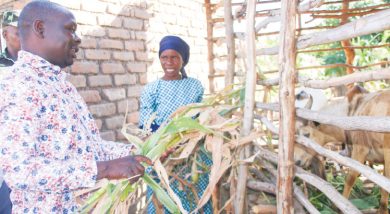Malosa’s tasty cassava flour
Rodwell Simon was out in his half-hectare cassava field when we met in Yoyola Village near Malosa, Zomba. The villager, who stopped growing maize in his garden in 2006, is one of almost 380 farmers cashing in on a factory that churns out improved cassava flour for baking.
“The crop has slightly been hit by chronic drought which forced me to stop growing maize, but I will yield enough surplus for sale to pay fees for my two children who are in secondary school,” he says.
The milling factory, owned by Chinangwa Mbatata Roots and Tubers Cooperative, has spurred the growing of the drought-resistant crop traditionally used for preparing nsima.

The cooperative offers the rural farmers a steady market, compelling many to abandon maize growing.
Raised by a single mother, Simon quit school in Standard Five. He was 17 when his mother died, leaving him as a sole breadwinner for his siblings.
He stayed put when his unskilled peers migrated to towns in search of better economic chances. He toiled on the maize field which reportedly produced no more than three 50-kilogramme bags a year.
“The harvest hardly took us to the next growing season,” he recalls.
He worked as a minibus callboy and a bicycle taxi operator at Malosa.
“The earnings were no better,” he says. “Then, I remembered my parents used to grow cassava for breakfast. The yield was good.”
With this flashback, he rushed to the cooperative with a workforce comprising five fulltime employees and 52 temporary labourers.
Today, he is among almost 380 farmers growing cassava for the cooperative established in 1999 to promote the growing of the crop for kondoole flour.
“Maize yields were falling and farmers were starving when they had enough land with favourable soils for cassava,” says factory manager Daniel Sandifolo in an interview at the factory.
Out of 378 farmers, 115 are corporative members. The membership comprises 11 men and 104 women.
Their cassava yields were promising from the start, they say.
In the backdrop of the milling factory is 2.6-hectare nursery of sauti and manyokola varieties. The plot is a source of cassava cuttings which the cooperative distributes to the farmers annually.
Unlike manyokola, sauti cassava is bitter and more popular because it is seldom eaten raw.
However, both varieties produce nutritious flour, which they mix with wheat flour to make fritters, doughnuts and scones described by consumers as uniquely tasty and more satisfying.
Cooperative members, with support from the African Development Foundation (ADF) and Cassava Adding Value for Africa programme at Chancellor College (Chanco), have branded the product “high quality cassava flour”.
Last year, the cooperative bought 90 tonnes of fresh cassava, producing almost 20 tonnes of the rising flour.
In that way, the farmers, who sell their yield to vendors at a giveaway price of no more than K30 a kilogramme, pocketed almost K4 million.
“We buy the tubers at K45 per kg at the factory and K40 on the farms. We offer higher prices than vendors because we want to improve the farmers’ livelihoods,” says Sandifolo.
The flour, worth K350 per kg, is on sale in various shops in Mulanje, Nkhota kota and Nkhata Bay.
The main customers include makers of fritters and doughnuts as well as bakeries and producers of fish feed.
The factory also produces kondoole flour for nsima, a staple for some parts of Karonga, Nkhata Bay, Rumphi, Mulanje and Zomba.
A study by the local arm of Cassava Transformation in Southern Africa Project shows only 30 in 100 Malawians regard it as number one food.
Some shop owners termed the rapidly produced cassava product more profitable than wheat flour.
Makers of fritters at Malosa say they spend less on cooking oil as cassava flour uses up to half the volume required for wheat flour.
“The taste is the only one of its kind. The budget for cooking oil is falling and profits have almost doubled up from the K27 000 I used to make,” says Alepha Phiri who sells mandasi at Zomba bus depot.
Market assessments show up to 15 percent profit hikes in bakeries and 35 percent for fish feed producers.
Similarly, the farmers are acquiring assets.
Simon has bought iron sheets and furniture for a modern brick house under construction. He expects to occupy it by 2018.





